7 Examples of High-Converting Landing Pages (2025 Analysis)
A great landing page is more than just a pretty design; it’s a conversion machine meticulously engineered to turn visitors into customers. Yet, a staggering number of landing pages fail to achieve this primary goal. They suffer from vague value propositions, confusing calls-to-action (CTAs), and a fundamental disconnect from user intent. The result is a high bounce rate and a leaking marketing funnel that wastes valuable ad spend and organic traffic. This isn't just about aesthetics; it's about strategic communication that guides a user toward a single, desired action.
This article dissects the anatomy of truly high-converting landing pages to reveal the replicable strategies behind their success. We will move beyond surface-level observations to provide a deep, tactical breakdown of what makes these examples work so well. For each one, you’ll find a comprehensive analysis of its design, copy, user experience, and psychological triggers. Beyond the visuals and text, technical excellence is also crucial. Factors like page speed and mobile responsiveness form the foundation of a good user experience; a slow page can kill conversions before your message is even seen. A solid grasp of website performance optimization is non-negotiable for building pages that perform.
Our goal is to give you actionable insights and a practical framework you can apply immediately. You'll learn how to craft compelling headlines, design frictionless forms, and structure layouts that drive action. We've included screenshots for quick reference and direct links to see each page in action. Forget generic advice; get ready for a masterclass in building high-converting landing pages that deliver measurable results.
1. Pages.Report
Pages.Report emerges as an essential, data-driven toolkit for SaaS companies aiming to build and optimize high-converting landing pages. It’s not just a gallery of examples; it's an all-in-one strategic platform that deconstructs what makes top-tier SaaS pages successful, transforming complex research into actionable, replicable insights. By curating and analyzing over 368 proven landing pages, the platform empowers marketers, founders, and product managers to bypass guesswork and implement strategies that are already validated in the market. This focus on data-backed best practices positions it as a powerful resource for accelerating growth and enhancing user experience from the very first touchpoint.

In-Depth Strategic Analysis
The core strength of Pages.Report lies in its detailed breakdown of successful landing page elements. Users can explore a vast library of examples meticulously categorized across more than 110 niches, from AI and productivity to finance and healthcare. This allows for hyper-relevant inspiration, ensuring the strategies are applicable to your specific industry.
The platform goes beyond surface-level visuals, offering deep dives into:
- UI/UX Patterns: Identify common layouts, navigation structures, and interactive elements that guide users seamlessly toward conversion.
- Compelling Copywriting: Analyze headlines, value propositions, and calls-to-action that resonate with target audiences and drive action.
- SEO & Marketing Tactics: Uncover the on-page SEO techniques and promotional strategies used by leading SaaS brands to attract qualified traffic.
This comprehensive analysis provides a clear roadmap for creating landing pages that not only look good but are strategically engineered for performance.
Key Strategic Insight: By dissecting the anatomy of hundreds of successful pages, Pages.Report enables teams to reverse-engineer success. Instead of starting from scratch, you can build upon proven frameworks, significantly reducing the time and risk associated with new page launches and A/B testing.
Practical Implementation & Unique Offerings
What truly sets Pages.Report apart is its emphasis on immediate application. The platform bridges the gap between inspiration and execution by providing ready-to-use Figma designs and support for Framer, Webflow, and custom code. This feature allows teams to quickly translate analytical insights into tangible assets, streamlining the design and development workflow.
The Pro package includes a standout feature: a free, personalized audit of your own landing page. This offering provides a detailed report with actionable recommendations, delivering bespoke optimization advice that is directly relevant to your business needs. Combined with weekly updates that add over 50 new examples, the platform ensures its content remains fresh, relevant, and aligned with current market trends.
Pricing, Access, and User Experience
Pages.Report operates on a lifetime access model, which, while a higher upfront investment, provides long-term value for serious SaaS businesses. The platform offers a free trial with no credit card required, allowing potential users to explore its core features and understand its value proposition firsthand.
The user interface is clean and intuitive, designed for efficient browsing and analysis. The categorization and search functionalities make it simple to find relevant examples, and the insights are presented in a digestible format. While the personalized audit slots are limited and can fill up quickly, the value they provide makes them a highly sought-after component of the Pro plan.
Website: https://pages.report
2. Unbounce
Unbounce is a veteran in the landing page space, meticulously engineered for marketers and agencies who need to build, test, and optimize high-converting landing pages without developer assistance. It stands out by moving beyond simple page building and focusing intensely on the conversion optimization lifecycle, making it an indispensable tool for serious performance marketing campaigns.
Its core strength lies in a powerful combination of a user-friendly drag-and-drop builder and sophisticated, AI-driven optimization tools. This allows teams to rapidly deploy dedicated pages for PPC, social media, and email campaigns, ensuring message match and a streamlined user journey.
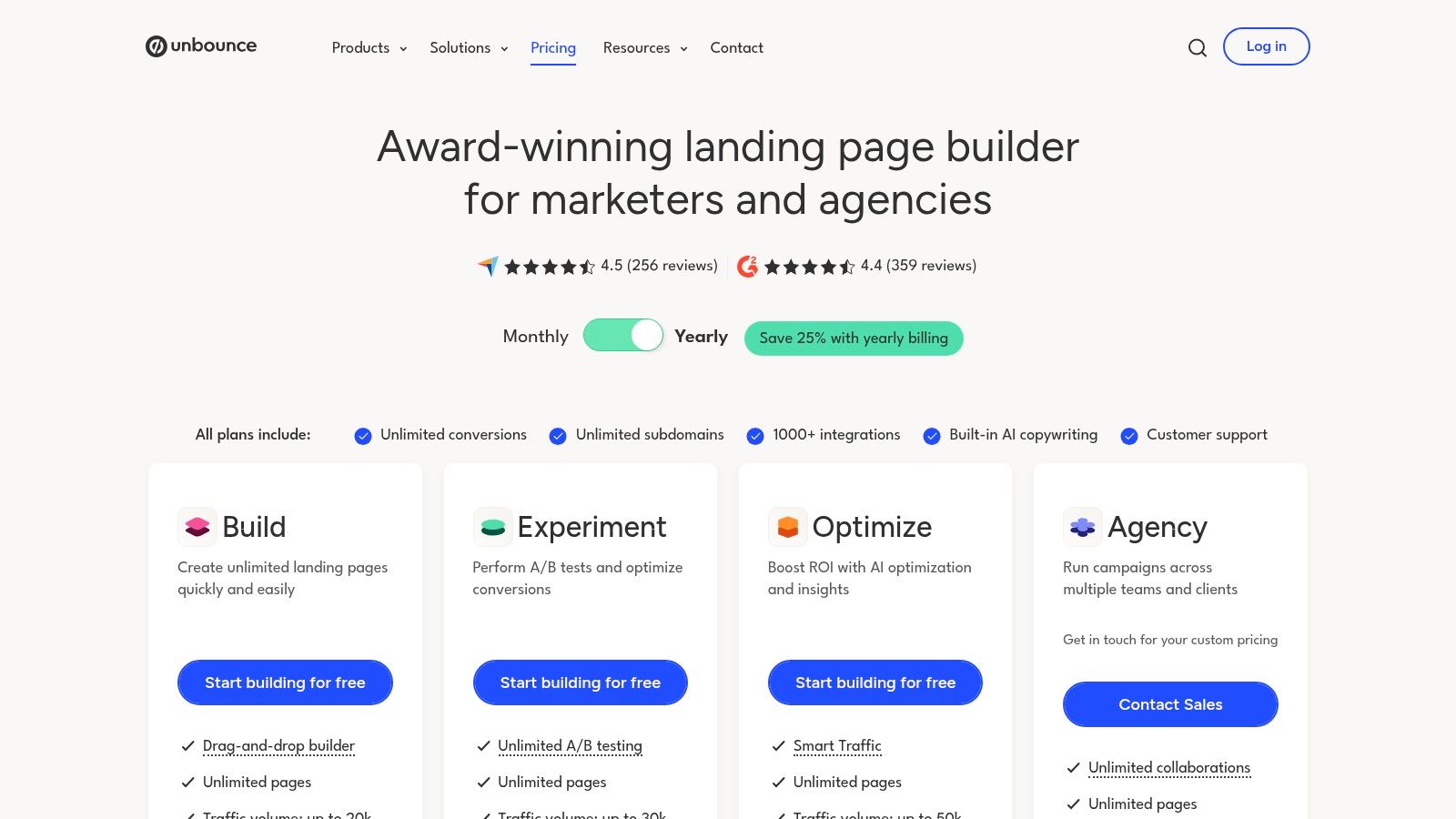
Strategic Breakdown: AI-Powered Conversion Science
Unbounce’s unique selling proposition is its suite of AI-powered features designed to remove guesswork from the optimization process. This is what truly elevates it from a standard page builder to a conversion platform.
- Smart Traffic: This is Unbounce's flagship feature. Instead of a traditional 50/50 A/B test, Smart Traffic uses AI to analyze a visitor's attributes (like device, location, and browser) and dynamically routes them to the landing page variant where they are most likely to convert. It learns and optimizes over time, often finding a "winner" faster than manual testing.
- Smart Copy: Integrated directly into the builder, this AI copywriting assistant helps generate and refine headlines, body copy, and CTA text. This speeds up the creative process and helps overcome writer's block, ensuring your pages are persuasive from the start.
- Dynamic Text Replacement (DTR): A critical tool for PPC advertisers, DTR automatically matches the text on your landing page to the keywords a visitor searched for. This creates a highly relevant and personalized experience, which is proven to boost Quality Scores and conversion rates.
Actionable Takeaway: When launching a new campaign with multiple page concepts, activate Smart Traffic from the beginning. It requires a minimum of 50 visitors to start optimizing but can significantly shorten the time it takes to identify the most effective page design and copy combination for different audience segments.
Pricing and Access
Unbounce operates on a tiered subscription model, with pricing structured around traffic volume, connected domains, and the number of conversions.
| Plan Tier | Key Features | Best For |
|---|---|---|
| Launch | Up to 20,000 visitors, 500 conversions | Small businesses starting with landing pages |
| Optimize | Up to 30,000 visitors, 1,000 conversions, Smart Traffic | Growth-focused marketers running multiple campaigns |
| Accelerate | Up to 50,000 visitors, 2,500 conversions | Agencies and marketing teams scaling their efforts |
While priced at a premium compared to basic website builders, the value is in its conversion-focused toolset. All plans include unlimited landing pages, popups, and sticky bars.
Pros:
- Best-in-class A/B testing and AI optimization tools.
- Vast template library designed for conversion.
- Extensive integration ecosystem (Salesforce, Marketo, Zapier, etc.).
Cons:
- Tiered plans have strict limits on traffic and conversions.
- The editor can have a steeper learning curve than simpler alternatives.
For teams whose success is measured in leads and sales, Unbounce provides the specialized tools necessary to create and refine some of the best high-converting landing pages in the industry.
Website: https://unbounce.com/
3. Instapage
Instapage positions itself as the premium solution for performance marketers and enterprises demanding speed, scale, and granular control over their post-click experiences. It's built for teams who need to move beyond basic page building and require a robust platform for personalization, experimentation, and campaign-wide consistency.
Its primary advantage is a focus on enterprise-grade features that streamline workflows for large-scale advertising. Instapage combines a pixel-perfect builder with advanced collaboration tools and unique features like AdMap, allowing teams to create, connect, and optimize hundreds of unique landing pages with unparalleled efficiency.
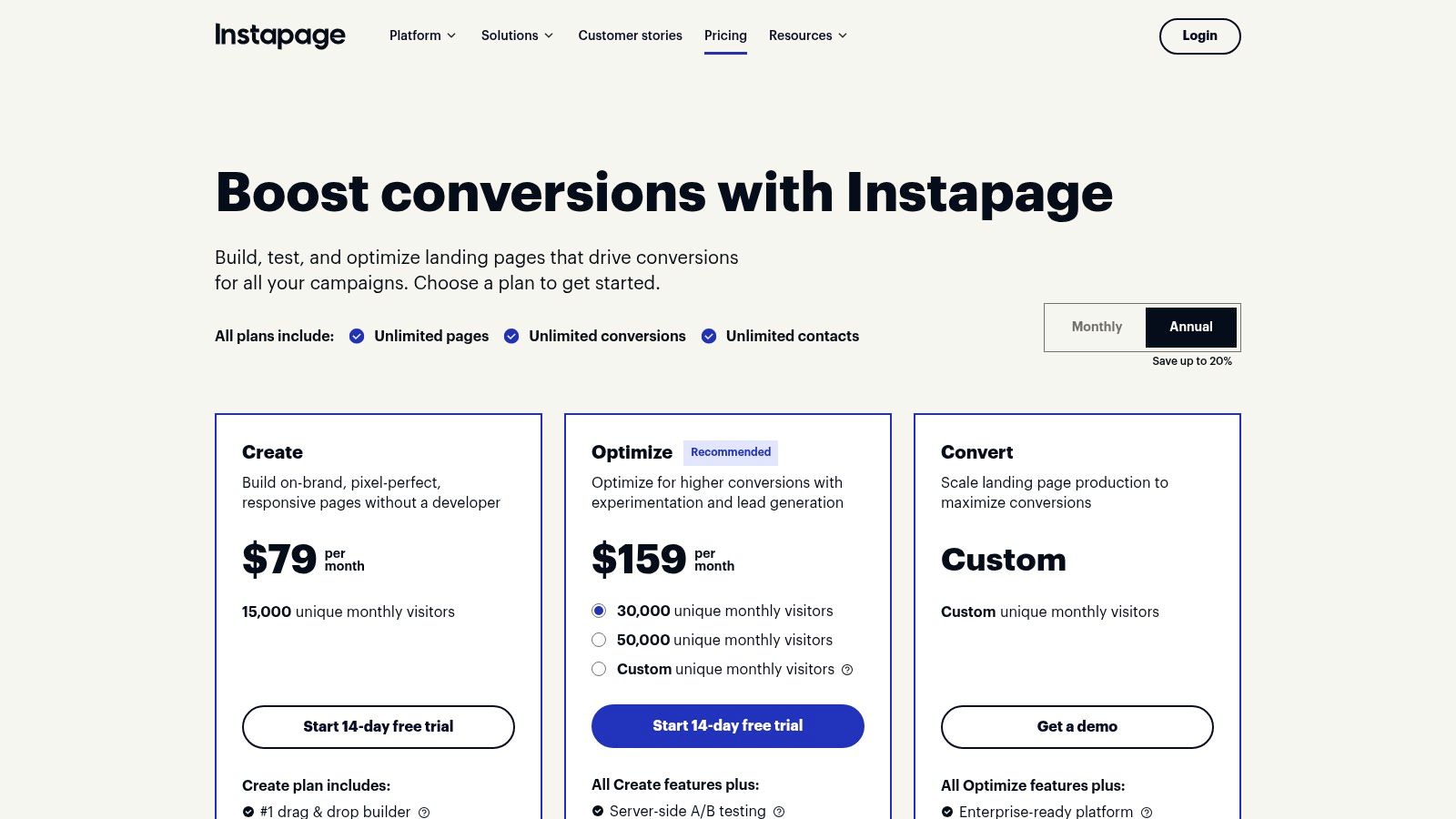
Strategic Breakdown: Scalable Personalization and Experimentation
Instapage excels by providing tools that directly address the challenges of managing numerous campaigns simultaneously. It’s designed to ensure every ad click leads to a relevant, optimized, and fast-loading page experience.
- AdMap®: This unique feature allows you to visualize your ad campaigns and easily connect specific ads or ad groups to corresponding, message-matched landing pages. This is a game-changer for maintaining a 1:1 ad-to-page personalization ratio at scale, which is crucial for maximizing ad spend ROI.
- Server-Side A/B Testing: Unlike client-side testing which can sometimes cause page flickering, Instapage runs experiments on the server. This ensures a faster, seamless user experience. It also provides sophisticated traffic splitting, allowing you to allocate precise percentages of visitors to different page variants.
- Instablocks® and Global Blocks: This feature allows you to create and save custom page sections (like headers, footers, or testimonial blocks) that can be used across multiple pages. When you update a Global Block, the change is instantly reflected on every page using it, saving countless hours of manual updates.
- Heatmaps: Built directly into the platform, heatmaps provide visual data on how visitors are interacting with your pages. You can track mouse movements, clicks, and scroll depth to identify areas of friction or opportunity for improvement.
Actionable Takeaway: Use the AdMap feature to conduct a full audit of your paid search campaigns. Ensure every high-value ad group has a dedicated, message-matched landing page. Then, use Instablocks to create a consistent footer and header across all pages to streamline brand management and future updates.
Pricing and Access
Instapage uses a tiered pricing model that is geared towards professional marketers and larger teams. The plans are primarily differentiated by features and traffic volume.
| Plan Tier | Key Features | Best For |
|---|---|---|
| Build | Visual Builder, Instablocks®, Limited Analytics | Individuals and small teams getting started |
| Optimize | A/B Testing, Heatmaps, Dynamic Text | Growth marketers focused on conversion optimization |
| Convert | AdMap®, Page Personalization, Global Blocks | Large teams and agencies managing campaigns at scale |
While it comes at a higher price point, the plans are generous, with all tiers including unlimited landing pages, domains, conversions, and contacts. The value lies in its advanced feature set designed to build and manage some of the best high-converting landing pages. For further inspiration, you can find more high-converting landing page examples from Instapage and other platforms to inform your design process.
Pros:
- Powerful experimentation and personalization toolkit.
- Excellent collaboration features for teams and agencies.
- Unique AdMap and Global Blocks features for scalable campaign management.
Cons:
- Significantly more expensive than entry-level builders.
- Core optimization features like A/B testing and Heatmaps are not on the base plan.
Website: https://instapage.com/plans
4. ClickFunnels
ClickFunnels is an all-in-one marketing platform designed around the concept of sales funnels rather than standalone landing pages. It’s built for entrepreneurs, course creators, and small businesses who need a single tool to guide visitors through a complete journey, from initial interest to final purchase and beyond. Its unique approach is less about isolated page optimization and more about engineering a profitable customer pathway.
The platform's core advantage is its unified system that combines a visual funnel builder with built-in e-commerce, email marketing, and membership site capabilities. This allows users to create cohesive campaigns where every step, from the landing page to the thank you page, is interconnected and optimized to maximize revenue.
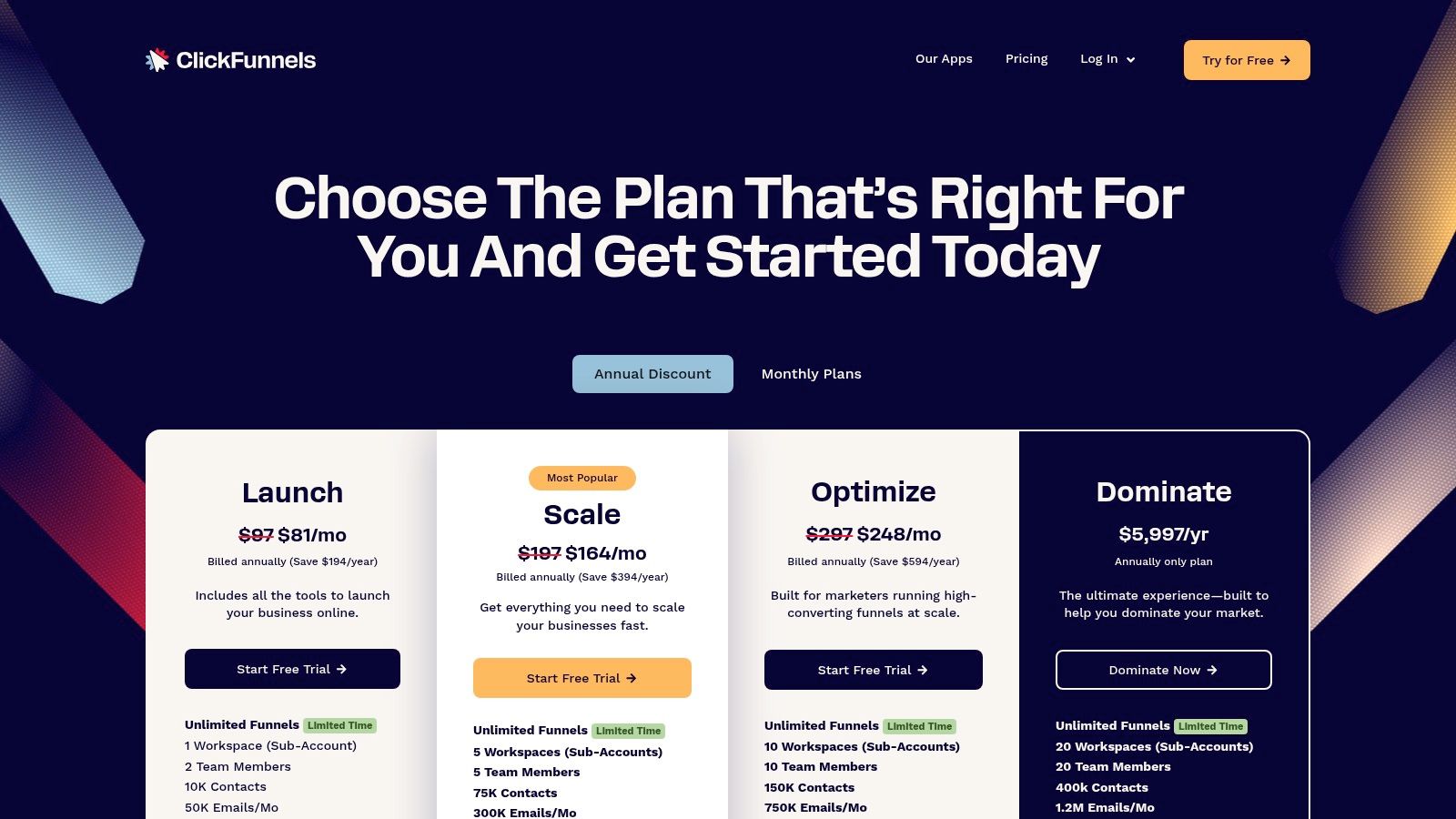
Strategic Breakdown: The End-to-End Monetization Funnel
ClickFunnels' unique selling proposition is its focus on the entire sales process, making it a powerful tool for direct-response marketing. It goes beyond lead capture to facilitate the entire transaction within its ecosystem.
- Visual Funnel Builder: This is the heart of ClickFunnels. Instead of just building a page, you map out an entire customer journey using proven templates like webinar funnels, product launch funnels, or membership funnels. This structure simplifies the creation of upsells, downsells, and one-time-offers, which are crucial for increasing average order value.
- Conversion Boosters: ClickFunnels pages often incorporate direct-response marketing elements designed to create urgency and social proof. Features like countdown timers, progress bars, and video sales letters are easily added, which is a key reason many users create effective high-converting landing pages with the tool. For more insights on this topic, discover how video can enhance landing pages.
- Integrated Actionetics & Backpack: On higher-tier plans, ClickFunnels includes a built-in email marketing and automation platform (Actionetics) and an affiliate management system (Backpack). This creates a closed-loop system where you can capture leads, nurture them, and empower others to sell your product all from one dashboard.
Actionable Takeaway: When building your first funnel, start with a pre-built template that matches your goal (e.g., lead magnet or tripwire funnel). Resist the urge to customize heavily at first. The templates are designed based on successful formulas; launch quickly, get traffic, and only then start A/B testing individual elements like headlines and CTAs.
Pricing and Access
ClickFunnels uses a tiered subscription model, with all plans including unlimited landing pages and visitor traffic. The main differences are the number of funnels, pages, and access to advanced features.
| Plan Tier | Key Features | Best For |
|---|---|---|
| Basic | 20 funnels, 100 pages, 1 user | Entrepreneurs starting their first online business |
| Pro | 100 funnels, 300 pages, 3 users | Growing businesses needing more capacity and API access |
| Funnel Hacker | Unlimited funnels & pages, 9 users, advanced analytics | Established businesses and agencies managing multiple brands |
While the entry point is accessible, the cost can grow as your business needs more advanced marketing automation and affiliate management tools. All plans come with a 14-day free trial.
Pros:
- End-to-end monetization in one platform (pages, payments, email).
- Large community and an extensive ecosystem of pre-built funnel templates.
- Strong focus on direct-response marketing tactics that drive sales.
Cons:
- The page editor's design flexibility is more focused on funnels than pure creative freedom.
- Pricing can become expensive as you scale and require more features.
For users whose primary goal is to sell products or services directly online, ClickFunnels provides a structured, all-in-one solution for building complete marketing and sales funnels.
Website: https://www.clickfunnels.com/pricing
5. Leadpages
Leadpages is an accessible and highly efficient platform designed for small businesses and entrepreneurs who need to quickly create and launch landing pages, pop-ups, and even simple websites. It has carved out a niche by focusing on ease of use, speed, and affordability, making it an excellent starting point for those who prioritize rapid deployment and lead generation without a steep learning curve or high budget.
Its core value is simplicity and value. By offering unlimited traffic and leads on all its plans, Leadpages removes a common barrier to entry, allowing users to scale their marketing efforts without worrying about hitting restrictive caps. The drag-and-drop builder is intuitive, supported by a large library of mobile-responsive templates that are optimized for conversion out of the box.
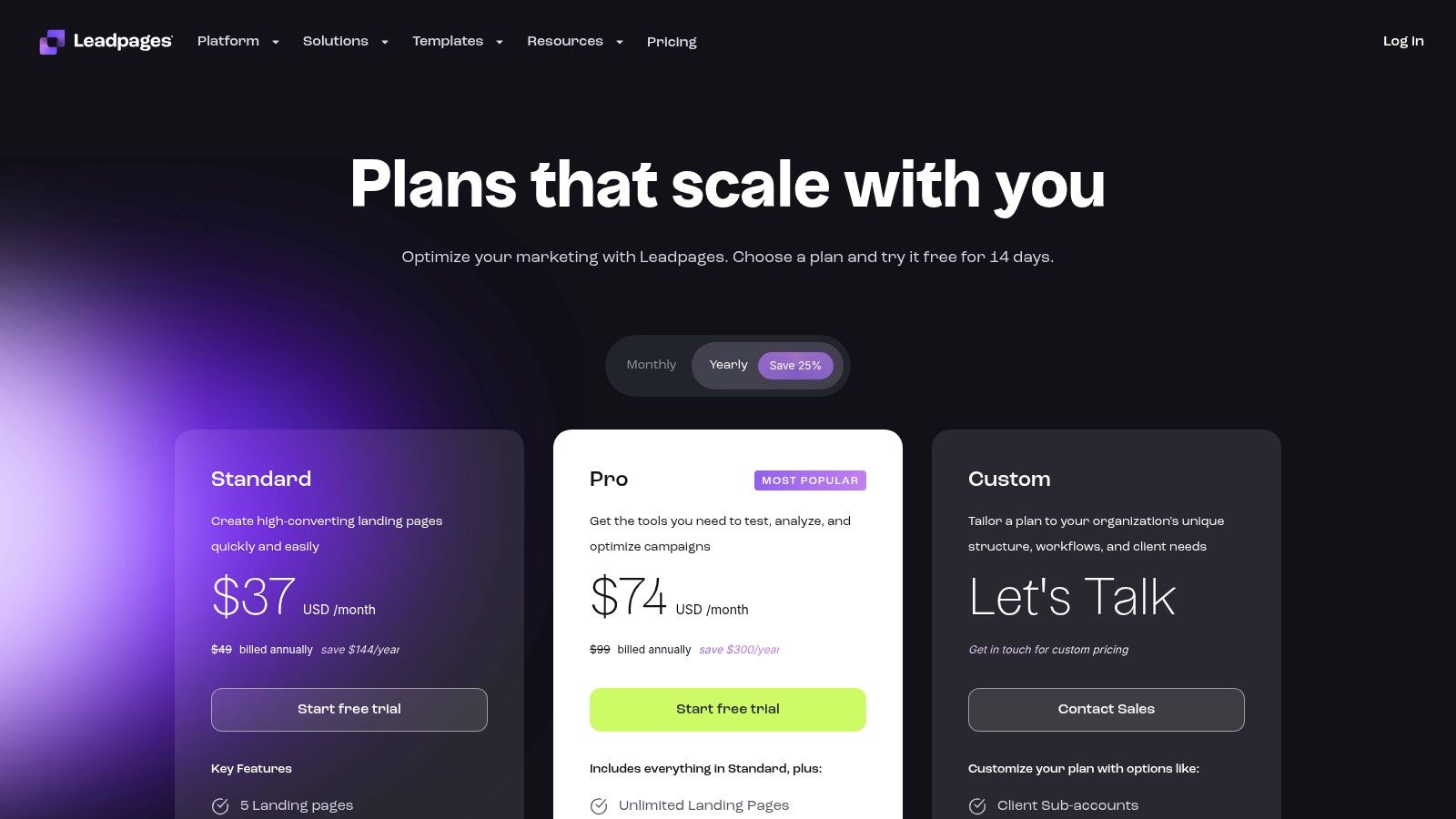
Strategic Breakdown: Speed, Simplicity, and Value
Leadpages' strategy is to empower users with the essential tools needed to convert visitors into leads and customers, without the complexity of more advanced platforms. This focus on core functionality makes it a powerhouse for straightforward campaigns.
- Unlimited Traffic & Leads: This is a major differentiator. While competitors often gate traffic and conversions behind higher-priced tiers, Leadpages provides this on all plans. This offers predictable costs and encourages users to drive as much traffic as possible to their pages.
- Large Template Library: With over 250 professionally designed templates, users can find a starting point for virtually any industry or campaign type. These templates are built with conversion best practices in mind, which significantly shortens the time from concept to launch.
- Built-in Conversion Tools: The platform isn't just a builder. It includes tools like pop-ups and alert bars that can be deployed across an entire website (not just on Leadpages-built pages) to capture visitor attention and drive sign-ups or sales.
Actionable Takeaway: Use the built-in analytics to identify your highest-performing landing page. Then, use the A/B testing feature (available on Pro plans) to duplicate that page and test one significant variable at a time, such as the main headline or the call-to-action button color. This iterative approach allows you to continuously improve your best high-converting landing pages.
Pricing and Access
Leadpages offers a straightforward pricing structure that is highly competitive, especially considering its unlimited traffic and lead generation policy.
| Plan Tier | Key Features | Best For |
|---|---|---|
| Standard | 1 Site, Landing Pages, Pop-Ups, Alert Bars | Solopreneurs and small businesses launching their first campaigns |
| Pro | 3 Sites, Online Sales & Payments, A/B Testing | Marketers and businesses needing to optimize and sell directly from pages |
| Advanced | Up to 50 Sites, Advanced Integrations | Marketing agencies and businesses managing multiple client websites |
All plans come with free hosting, a library of mobile-responsive templates, and access to their well-regarded customer support team.
Pros:
- Excellent value with unlimited leads and traffic on all plans.
- Very intuitive and easy-to-use drag-and-drop editor.
- Lower entry price compared to many advanced competitors.
Cons:
- A/B testing and online payment features are not available on the base plan.
- Fewer advanced customization and optimization features than Unbounce or Instapage.
For those who need to build effective, high-converting landing pages quickly and affordably, Leadpages offers one of the best balances of functionality and price on the market.
Website: https://www.leadpages.com/pricing
6. HubSpot (Marketing Hub + Content/Website tools)
HubSpot is not just a landing page builder; it’s a comprehensive marketing platform where landing pages are a fully integrated component of a much larger ecosystem. It is designed for businesses that want to connect every touchpoint, from the initial ad click to the final sale, within a single, unified system. This all-in-one approach eliminates data silos and provides unparalleled insight into the entire customer lifecycle.
Its core strength is the native integration between its landing page tool, CRM, email marketing, automation, and reporting dashboards. This allows marketers to build pages that are not only visually appealing but also deeply connected to lead nurturing sequences and sales pipelines, making it a powerhouse for creating truly high-converting landing pages that contribute directly to revenue.
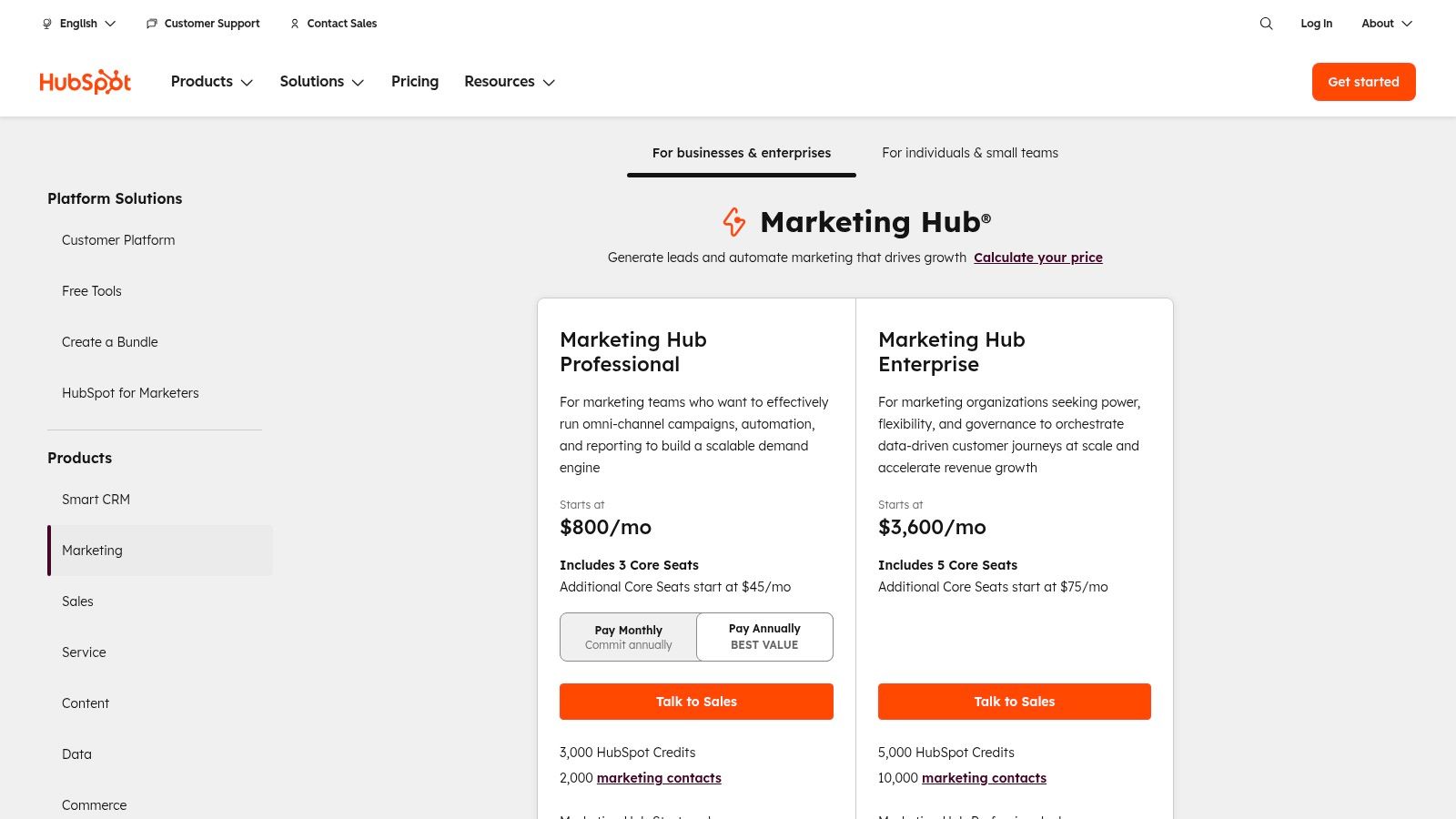
Strategic Breakdown: The All-in-One Conversion Engine
HubSpot's unique value lies in its ability to leverage data from its CRM to create highly personalized and context-aware landing page experiences. This moves beyond simple page creation and into a holistic conversion rate optimization strategy that spans the entire marketing and sales funnel.
- Smart Content & Personalization: This feature allows you to show different versions of your content (headlines, CTAs, images) to visitors based on their lifecycle stage, list membership, or any contact property stored in the HubSpot CRM. A first-time visitor might see a "Download Ebook" CTA, while a known lead sees a "Request a Demo" CTA on the same page.
- Integrated A/B and Adaptive Testing: HubSpot offers robust A/B testing capabilities, allowing you to test variations of your pages to optimize performance. The higher-tier adaptive testing feature uses machine learning to automatically direct more traffic to the winning variation over time, maximizing conversions without manual intervention.
- Unified Attribution Reporting: Because the landing page tool is part of the broader Marketing Hub, you can instantly see which pages, campaigns, and channels are driving the most qualified leads and customers. This closed-loop reporting is a significant advantage over using disconnected tools.
Actionable Takeaway: Use the Smart Content feature to personalize your landing page CTAs based on a visitor's lifecycle stage in your CRM. For anonymous visitors, offer a top-of-funnel content piece. For leads, offer a middle-of-funnel asset like a case study. For Marketing Qualified Leads (MQLs), present a bottom-of-funnel demo request to accelerate the sales process.
Pricing and Access
HubSpot's landing page tools are part of the Marketing Hub, which uses a tiered subscription model based on features and the number of marketing contacts.
| Plan Tier | Key Features | Best For |
|---|---|---|
| Starter | Basic landing pages, forms, live chat | Small businesses needing simple lead capture pages tied to a CRM |
| Professional | A/B testing, Smart Content, campaign reporting | Growing teams focused on personalization and campaign optimization |
| Enterprise | Adaptive testing, custom objects, multi-touch revenue attribution | Large organizations requiring advanced analytics and governance |
While the initial investment for Professional and Enterprise tiers is significant (often including onboarding fees), the value comes from consolidating your tech stack and gaining deep, actionable insights. Many top-performing SaaS brands leverage this platform; you can see examples in this analysis of the best SaaS websites.
Pros:
- All-in-one platform minimizes the need for third-party integrations.
- Powerful analytics and revenue attribution capabilities.
- Highly scalable, from free tools to enterprise-level solutions.
Cons:
- Professional/Enterprise plans have mandatory onboarding fees.
- Pricing scales with the number of contacts, which can become expensive.
- Can be overly complex if you only need a standalone landing page builder.
For businesses committed to an inbound marketing strategy, HubSpot provides the integrated tools needed to not just build landing pages, but to turn them into the central hub of a powerful lead generation and nurturing machine.
Website: https://www.hubspot.com/pricing/marketing
7. ThemeForest (Envato Market)
ThemeForest, part of the Envato Market, is not a landing page builder but a massive marketplace for one-time-purchase templates. It serves developers, designers, and marketers who prefer to leverage pre-built designs on their existing platforms like WordPress, HTML/CSS, or even dedicated builders like Unbounce. It stands out by offering an almost endless library of designs, allowing users to find a niche-specific, conversion-focused template without a recurring subscription.
This approach is ideal for those who have the technical skills or platform (like Elementor or a custom-coded site) to implement a template but want to skip the initial design and wireframing process. It decouples the design from the platform, providing maximum flexibility and ownership over the final asset.
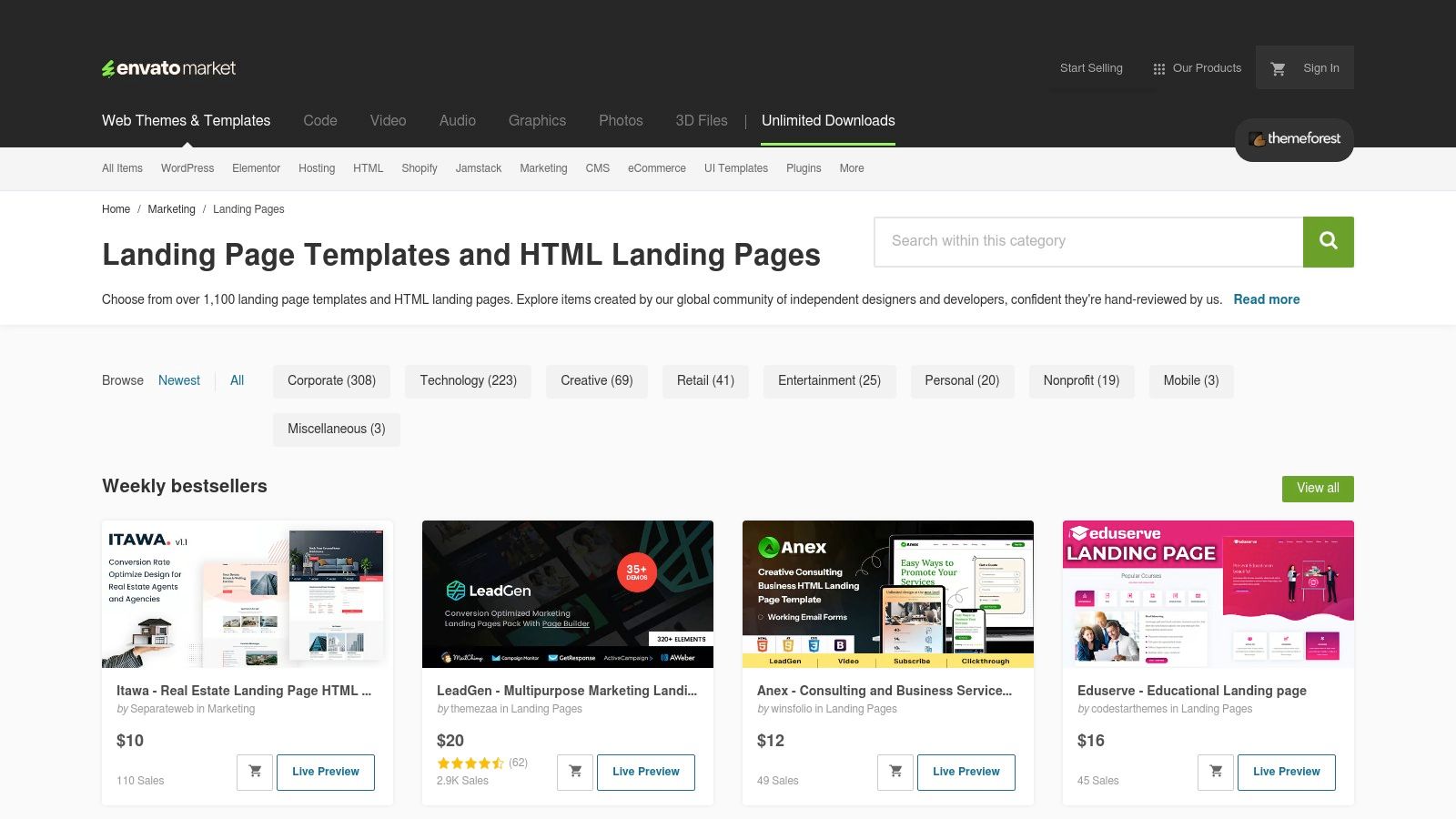
Strategic Breakdown: A Library of Conversion Blueprints
ThemeForest's primary value is its sheer volume and diversity, acting as a repository of battle-tested design patterns. The best templates on the market are often popular because they have proven conversion principles baked into their structure, which new buyers can leverage instantly.
- Niche-Specific Designs: Unlike generic builders, you can find templates meticulously crafted for specific industries, from SaaS and mobile apps to real estate and online courses. These often include relevant sections and layouts that resonate with a particular target audience.
- Platform Versatility: The marketplace is segmented by technology. You can find standalone HTML5 templates, fully-integrated WordPress themes with drag-and-drop builders like Elementor or WPBakery, and even files compatible with third-party landing page software.
- Community-Driven Validation: Each template has a rating, number of sales, and a comments section. This social proof acts as a quality filter, helping you identify templates that are well-coded, well-supported, and have a history of success for other buyers.
Actionable Takeaway: When searching for a template, don't just look at the live demo. Pay close attention to the "Last Updated" date, buyer reviews, and the author's comment response time. A recently updated template from a responsive author is a much safer investment and is more likely to be optimized for modern high-converting landing pages.
Pricing and Access
ThemeForest operates on a per-template licensing model. You pay a one-time fee for a license to use the template on a single end-product.
| License Type | Key Features | Best For |
|---|---|---|
| Regular License | Use in a single end-product which end users are not charged for. | A landing page for your own business or a single client project. |
| Extended License | Use in a single end-product which end users can be charged for. | A product where the template is a core part of what you sell. |
Prices are set by the authors and typically range from $10 to $79, making it a highly cost-effective option. Extended support from the author is often available for an additional fee.
Pros:
- Vast selection of designs at affordable one-time prices.
- Templates available for numerous platforms (HTML, WordPress, etc.).
- Buyer ratings and sales data help identify quality items.
Cons:
- Quality and support can vary significantly between authors.
- Requires you to handle hosting, setup, and integration yourself.
- No built-in A/B testing or optimization tools.
For users with an existing platform and the ability to customize a template, ThemeForest is an unparalleled resource for acquiring professionally designed, high-converting landing pages without the commitment of a monthly subscription.
Website: https://themeforest.net/category/marketing/landing-pages
High-Converting Landing Page Tools Comparison
| Platform | Implementation Complexity 🔄 | Resource Requirements ⚡ | Expected Outcomes 📊 | Ideal Use Cases 💡 | Key Advantages ⭐ |
|---|---|---|---|---|---|
| Pages.Report | Moderate – requires some design implementation | Medium – access to Figma designs and marketing support | High – data-driven conversion optimization | SaaS startups and marketers seeking proven landing page success | Extensive SaaS landing page database, free audit |
| Unbounce | Low to Moderate – drag-and-drop with AI tools | Medium – user-friendly platform with integrations | High – optimized for conversion testing and campaigns | Marketers/agencies running PPC, ads, and lead gen campaigns | AI Smart Traffic, unlimited landing pages, strong integrations |
| Instapage | Moderate to High – advanced testing and personalization | Medium to High – premium features and collaboration | Very High – pixel-perfect pages, enterprise-grade testing | Performance marketers managing many campaigns at scale | Enterprise features, robust experimentation toolkit |
| ClickFunnels | Moderate – funnel-focused builder with automations | Medium to High – includes payments, email, and automation | High – full funnel conversion and monetization | Creators/SMBs needing funnels plus checkout/email solutions | All-in-one funnel + monetization, strong template community |
| Leadpages | Low – simple drag-and-drop builder | Low to Medium – budget-friendly with hosting included | Moderate – fast setup with unlimited traffic/leads | Beginners or budget-conscious users needing quick builds | Affordable, unlimited leads/traffic, US-based support |
| HubSpot (Marketing Hub) | High – full marketing suite with CRM integration | High – requires onboarding, scalable enterprise options | Very High – unified attribution and lead nurturing | Businesses needing integrated marketing stack and analytics | All-in-one marketing stack, strong attribution |
| ThemeForest (Envato Market) | High – DIY template purchase and integration | Low to Medium – one-time purchase but requires setup | Variable – depends on template quality and user skill | Users preferring template ownership and self-managed platforms | Large variety, affordable, many niche-specific designs |
Your Blueprint for a High-Converting Landing Page
We've dissected some of the best high-converting landing pages, from the minimalist genius of Dropbox to the vibrant, benefit-driven design of Asana. Each example, powered by tools like Unbounce, Instapage, and HubSpot, serves as a masterclass in conversion-focused design. But simply admiring these pages isn't enough; the goal is to distill their success into a repeatable blueprint for your own campaigns.
Across all the standout examples, a clear pattern emerges. The most effective landing pages are not just visually appealing; they are strategic instruments meticulously engineered to guide a user toward a single, specific action. They achieve this by mastering a core set of principles: absolute clarity in the value proposition, a frictionless user experience, and compelling social proof that builds immediate trust.
Synthesizing the Core Principles
Let's recap the foundational pillars we observed. These are the non-negotiables for building your own high-converting landing pages.
- Clarity Above All: Your headline and subheadline must answer three questions in under five seconds: What is this offer? Who is it for? Why should they care? As we saw with Slack's landing page, a direct, benefit-oriented headline removes all guesswork.
- Singular Focus: Every element on the page, from the copy to the images and the CTA button, must support a single conversion goal. Pages built with tools like Leadpages and ClickFunnels excel here, often removing navigation menus to eliminate exit points and keep users focused on the intended action.
- Visual Hierarchy that Guides: Strong landing pages use design to direct the user's eye. We saw this in Shopify’s use of contrasting colors for their CTA and the strategic placement of testimonials. Your design should create a natural path leading directly to the conversion button.
- Trust Through Authenticity: Social proof is your most powerful asset. Whether it's customer logos, specific testimonials, or case study snippets, proof from real users disarms skepticism. HubSpot’s pages masterfully integrate case studies and data points to validate their claims.
From Blueprint to Build: Choosing Your Tools and Tactics
Now, how do you translate this blueprint into a functional, high-performing asset? The first step is selecting the right tool for your specific needs and resources.
- For Rapid Experimentation: If your priority is A/B testing and quick deployment, platforms like Unbounce and Instapage are built for this. Their drag-and-drop editors and robust testing features allow marketers to iterate without developer dependency.
- For Integrated Sales Funnels: If your landing page is part of a larger, multi-step sales funnel, a tool like ClickFunnels provides the structure to connect pages, upsells, and payment processing seamlessly.
- For All-in-One Marketing Ecosystems: If you need your landing page to connect directly to your CRM, email marketing, and analytics, HubSpot offers a powerful, integrated solution. This is ideal for teams that need a single source of truth for their marketing data.
- For Budget-Conscious Customization: For those with design and development skills, using a high-quality template from ThemeForest on a WordPress site can be a cost-effective way to get started, though it requires more hands-on management.
Building your blueprint for a high-converting landing page requires employing effective and measurable tactics. To go deeper on the testing and optimization side of this process, explore these 9 Proven Conversion Rate Optimization Strategies to ensure your design and copy changes are backed by data. Implementing these strategies is what separates a good landing page from a great one.
Ultimately, the journey to creating high-converting landing pages is one of continuous improvement. The examples we’ve explored are not static; they are the result of countless tests, tweaks, and a relentless focus on the user. Embrace this mindset of perpetual optimization. Launch, measure, learn, and repeat. Your next high-converting landing page is not just a possibility; it's an inevitability waiting to be built.
Ready to move from theory to action? Stop guessing what works and start analyzing the world's best landing pages. Pages.Report gives you an exclusive look into the design, copy, and technology behind top-performing pages, providing the competitive intelligence you need to build your own conversion machine. Get your first report on Pages.Report and start building smarter today.
